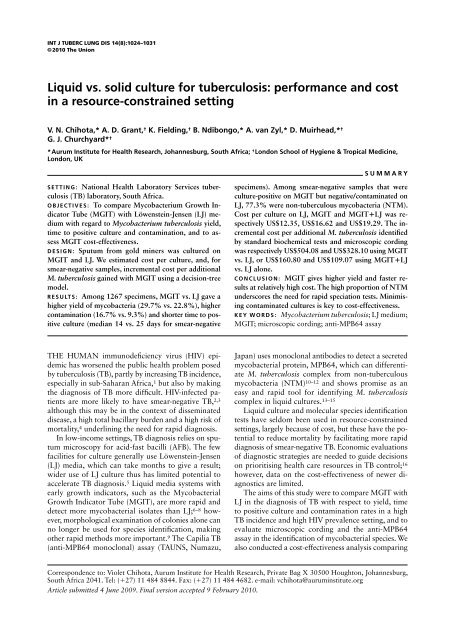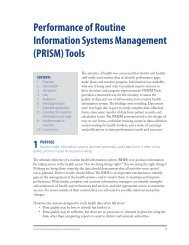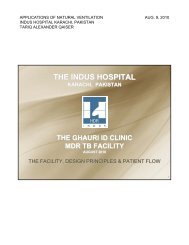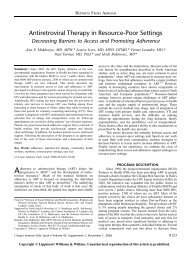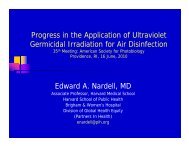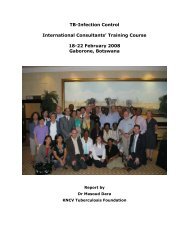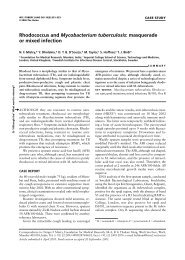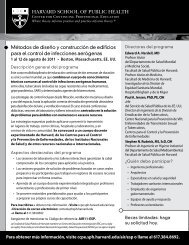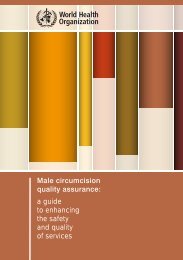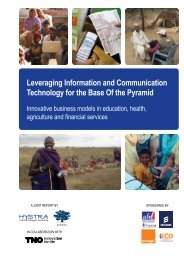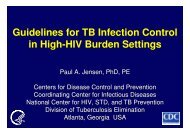Liquid vs. solid culture for tuberculosis: performance ... - GHDonline
Liquid vs. solid culture for tuberculosis: performance ... - GHDonline
Liquid vs. solid culture for tuberculosis: performance ... - GHDonline
You also want an ePaper? Increase the reach of your titles
YUMPU automatically turns print PDFs into web optimized ePapers that Google loves.
INT J TUBERC LUNG DIS 14(8):1024–1031<br />
© 2010 The Union<br />
<strong>Liquid</strong> <strong>vs</strong>. <strong>solid</strong> <strong>culture</strong> <strong>for</strong> <strong>tuberculosis</strong>: per<strong>for</strong>mance and cost<br />
in a resource-constrained setting<br />
V. N. Chihota,* A. D. Grant, † K. Fielding, † B. Ndibongo,* A. van Zyl,* D. Muirhead,* †<br />
G. J. Churchyard* †<br />
* Aurum Institute <strong>for</strong> Health Research, Johannesburg, South Africa; † London School of Hygiene & Tropical Medicine,<br />
London, UK<br />
SUMMARY<br />
SETTING: National Health Laboratory Services <strong>tuberculosis</strong><br />
(TB) laboratory, South Africa.<br />
OBJECTIVES: To compare Mycobacterium Growth Indicator<br />
Tube (MGIT) with Löwenstein-Jensen (LJ) medium<br />
with regard to Mycobacterium <strong>tuberculosis</strong> yield,<br />
time to positive <strong>culture</strong> and contamination, and to assess<br />
MGIT cost-effectiveness.<br />
DESIGN: Sputum from gold miners was <strong>culture</strong>d on<br />
MGIT and LJ. We estimated cost per <strong>culture</strong>, and, <strong>for</strong><br />
smear-negative samples, incremental cost per additional<br />
M. <strong>tuberculosis</strong> gained with MGIT using a decision-tree<br />
model.<br />
RESULTS: Among 1267 specimens, MGIT <strong>vs</strong>. LJ gave a<br />
higher yield of mycobacteria (29.7% <strong>vs</strong>. 22.8%), higher<br />
contamination (16.7% <strong>vs</strong>. 9.3%) and shorter time to positive<br />
<strong>culture</strong> (median 14 <strong>vs</strong>. 25 days <strong>for</strong> smear-negative<br />
specimens). Among smear-negative samples that were<br />
<strong>culture</strong>-positive on MGIT but negative/contaminated on<br />
LJ, 77.3% were non-tuberculous mycobacteria (NTM).<br />
Cost per <strong>culture</strong> on LJ, MGIT and MGIT+LJ was respectively<br />
US$12.35, US$16.62 and US$19.29. The incremental<br />
cost per additional M. <strong>tuberculosis</strong> identified<br />
by standard biochemical tests and microscopic cording<br />
was respectively US$504.08 and US$328.10 using MGIT<br />
<strong>vs</strong>. LJ, or US$160.80 and US$109.07 using MGIT+LJ<br />
<strong>vs</strong>. LJ alone.<br />
CONCLUSION: MGIT gives higher yield and faster results<br />
at relatively high cost. The high proportion of NTM<br />
underscores the need <strong>for</strong> rapid speciation tests. Minimising<br />
contaminated <strong>culture</strong>s is key to cost-effectiveness.<br />
KEY WORDS: Mycobacterium <strong>tuberculosis</strong>; LJ medium;<br />
MGIT; microscopic cording; anti-MPB64 assay<br />
THE HUMAN immunodeficiency virus (HIV) epidemic<br />
has worsened the public health problem posed<br />
by <strong>tuberculosis</strong> (TB), partly by increasing TB incidence,<br />
especially in sub-Saharan Africa, 1 but also by making<br />
the diagnosis of TB more difficult. HIV-infected patients<br />
are more likely to have smear-negative TB, 2,3<br />
although this may be in the context of disseminated<br />
disease, a high total bacillary burden and a high risk of<br />
mortality, 4 underlining the need <strong>for</strong> rapid diagnosis.<br />
In low-income settings, TB diagnosis relies on sputum<br />
microscopy <strong>for</strong> acid-fast bacilli (AFB). The few<br />
facilities <strong>for</strong> <strong>culture</strong> generally use Löwenstein-Jensen<br />
(LJ) media, which can take months to give a result;<br />
wider use of LJ <strong>culture</strong> thus has limited potential to<br />
accelerate TB diagnosis. 5 <strong>Liquid</strong> media systems with<br />
early growth indicators, such as the Mycobacterial<br />
Growth Indicator Tube (MGIT), are more rapid and<br />
detect more mycobacterial isolates than LJ; 6–8 however,<br />
morphological examination of colonies alone can<br />
no longer be used <strong>for</strong> species identification, making<br />
other rapid methods more important. 9 The Capilia TB<br />
(anti-MPB64 monoclonal) assay (TAUNS, Numazu,<br />
Japan) uses monoclonal antibodies to detect a secreted<br />
mycobacterial protein, MPB64, which can differentiate<br />
M. <strong>tuberculosis</strong> complex from non-tuberculous<br />
mycobacteria (NTM) 10–12 and shows promise as an<br />
easy and rapid tool <strong>for</strong> identifying M. <strong>tuberculosis</strong><br />
complex in liquid <strong>culture</strong>s. 13–15<br />
<strong>Liquid</strong> <strong>culture</strong> and molecular species identification<br />
tests have seldom been used in resource-constrained<br />
settings, largely because of cost, but these have the potential<br />
to reduce mortality by facilitating more rapid<br />
diagnosis of smear-negative TB. Economic evaluations<br />
of diagnostic strategies are needed to guide decisions<br />
on prioritising health care resources in TB control; 16<br />
however, data on the cost-effectiveness of newer diagnostics<br />
are limited.<br />
The aims of this study were to compare MGIT with<br />
LJ in the diagnosis of TB with respect to yield, time<br />
to positive <strong>culture</strong> and contamination rates in a high<br />
TB incidence and high HIV prevalence setting, and to<br />
evaluate microscopic cording and the anti-MPB64<br />
assay in the identification of mycobacterial species. We<br />
also conducted a cost-effectiveness analysis comparing<br />
Correspondence to: Violet Chihota, Aurum Institute <strong>for</strong> Health Research, Private Bag X 30500 Houghton, Johannesburg,<br />
South Africa 2041. Tel: (+27) 11 484 8844. Fax: (+27) 11 484 4682. e-mail: vchihota@auruminstitute.org<br />
Article submitted 4 June 2009. Final version accepted 9 February 2010.
MGIT <strong>vs</strong>. L J in gold mines in South Africa 1025<br />
MGIT and MGIT+LJ with LJ alone, including standard<br />
biochemical assays, cording and anti-MPB64<br />
assay in the diagnosis of smear-negative TB.<br />
The study was nested within a cluster randomised<br />
trial of community-wide isoniazid preventive treatment<br />
(IPT), ‘Thibela TB’ (meaning ‘Prevent TB’ in seSotho),<br />
in three South African gold mining companies.<br />
METHODS<br />
Study population<br />
TB suspects were enrolled from routine mine health<br />
services participating in the Thibela TB study (limited<br />
to individuals with no previous history of TB); and<br />
from the Thibela TB study, at screening and prior to<br />
or during follow-up visits while taking IPT (regardless<br />
of TB history). Participants gave one on-the-spot<br />
sputum sample, after nebulisation if necessary.<br />
Laboratory methods<br />
All laboratory work was undertaken at the National<br />
Health Laboratory Services regional TB laboratory in<br />
Johannesburg, South Africa. Specimens were decontaminated<br />
using the sodium hydroxide-N-acetyl-Lcystein<br />
(NaOH-NALC) method and concentrated<br />
by centrifugation. 17 The pellet was resuspended in 1–<br />
2 ml of sterile phosphate buffer (pH 6.8), and an<br />
a uramine-stained smear was examined under a fluorescence<br />
microscope; 0.5 ml of sediment was <strong>culture</strong>d<br />
using the BACTEC MGIT 960 system (BD Diagnostic<br />
Systems, Sparks, MD, USA); another 0.5 ml<br />
was inoculated onto an LJ slant. Positive <strong>culture</strong>s<br />
were confirmed by examining Ziehl-Neelsen (ZN)<br />
stained smears <strong>for</strong> AFB. Mycobacteria were identified<br />
using 1) standard biochemical tests (growth rate<br />
at 25°C and 37°C, pigment production, susceptibility<br />
to p-nitrobenzoic acid and biochemical tests, including<br />
68°C heat stable catalase, nitrate reduction<br />
test and Tween 80 hydrolysis), 18 2) the anti-MPB64<br />
mono clonal antibody assay (TAUNS) following the<br />
manufacturer’s instructions, and 3) by examining<br />
smears <strong>for</strong> microscopic serpentine cords of AFB. 19 A<br />
<strong>culture</strong> that was considered contaminated was only<br />
re-decontaminated and re-<strong>culture</strong>d if the ZN-stained<br />
smears were positive <strong>for</strong> AFB.<br />
Statistical methods<br />
Data were analysed using Stata version 10.0 (STATA,<br />
College Station, TX, USA). The time to positive <strong>culture</strong><br />
was summarised using Kaplan-Meier curves, stratified<br />
by smear status and compared between <strong>culture</strong><br />
methods using the Wilcoxon signed-ranks test.<br />
Using standard biochemical testing as the gold<br />
standard, the sensitivity and specificity of microscopic<br />
cording and the anti-MPB64 assay in identifying<br />
M. <strong>tuberculosis</strong> were determined, stratified by smear<br />
status. The 95% confidence intervals (CIs) <strong>for</strong> sensitivity<br />
and specificity were calculated using the exact<br />
binomial method.<br />
Cost analyses<br />
Economic cost analyses from a provider perspective<br />
compared LJ alone to 1) MGIT alone and 2) MGIT+<br />
LJ, each in conjunction with anti-MPB64 assay or<br />
cording <strong>vs</strong>. standard biochemical assay. Cost per <strong>culture</strong><br />
(based on all specimens) and per M. <strong>tuberculosis</strong><br />
case identified were calculated from time of arrival of<br />
specimens to identification of mycobacterial species<br />
in the laboratory. Specimen collection, transport to<br />
the laboratory and return of results were costed, but<br />
the costs were excluded on the basis that they were<br />
study-specific and not generalisable.<br />
All resources used in the steps required <strong>for</strong> culturing<br />
were measured using an ingredients-based approach.<br />
Infrastructure costs were obtained through<br />
capital audit and apportioned to the diagnostic process<br />
based on proportion of time and space used. Capital<br />
costs were annualised using a useful life of 20 years<br />
<strong>for</strong> buildings, 5 years <strong>for</strong> furniture and 6 years <strong>for</strong><br />
equipment and a discount rate of 3%. 20 Use of laboratory,<br />
medical and other supplies was measured<br />
through detailed staff re-enactment of specimen processing.<br />
Staff time in laboratory was estimated by<br />
staff interview. Administrative staff time and supplies<br />
were included in the costing, but laboratory overhead<br />
costs (equipment maintenance, lighting, cleaning,<br />
water, etc.) were not available at the time of data collection<br />
and these were there<strong>for</strong>e estimated at 5% of<br />
all capital items at the laboratory. 21<br />
All costs were valued at current market prices<br />
and expressed in 2007 $US, using an exchange rate<br />
of US$1 = ZAR7.00 (as estimated <strong>for</strong> 30 June<br />
2007, the end of the study period, using http://www.<br />
x-rates.com).<br />
Cost-effectiveness<br />
Cost-effectiveness analysis was restricted to smearnegative<br />
specimens. The incremental cost per additional<br />
positive <strong>culture</strong> and additional M. <strong>tuberculosis</strong><br />
isolated using MGIT or MGIT+LJ <strong>vs</strong>. LJ alone, speciated<br />
by standard biochemical tests, anti-MPB64<br />
assay or microscopic cording, was calculated using a<br />
decision tree model programmed in Excel 2003 (Micro-<br />
Soft, Redmond, WA, USA). For the cost per additional<br />
M. <strong>tuberculosis</strong> case isolated, the same species identification<br />
method was used <strong>for</strong> the positive <strong>culture</strong><br />
system (MGIT or MGIT+LJ) and the comparator<br />
LJ alone.<br />
Sensitivity analysis<br />
The base-case scenario assumed that the MGIT system<br />
was used at 75% throughput (as was observed<br />
with MGIT systems used under routine conditions in<br />
the same laboratory), 5% overheads and 16% contamination<br />
rate of MGIT <strong>culture</strong>s (as observed). This
1026 The International Journal of Tuberculosis and Lung Disease<br />
differed from the actual study conditions, where the<br />
MGIT system was used exclusively <strong>for</strong> study specimens<br />
and ran at 4% capacity. In a sensitivity analysis,<br />
we explored a low-cost scenario assuming an MGIT<br />
system throughput of 100% and a high-cost scenario<br />
assuming 50% throughput and overheads of 25%.<br />
For all cost-effectiveness estimates, we also explored<br />
the effect of reducing the proportion of MGIT <strong>culture</strong>s<br />
contaminated from 16% (as observed) to 4%<br />
(the best achieved in this laboratory using an alternative<br />
decontamination regimen [unpublished data]),<br />
assuming the proportion of specimens yielding M. <strong>tuberculosis</strong><br />
was the same in contaminated and uncontaminated<br />
samples.<br />
Ethical considerations<br />
All participants who provided a sputum specimen gave<br />
written or witnessed verbal in<strong>for</strong>med consent. The<br />
study was approved by the Research Ethics Committees<br />
of the University of KwaZulu-Natal and the London<br />
School of Hygiene & Tropical Medicine.<br />
RESULTS<br />
Participants<br />
From July 2006 to June 2007, 1267 specimens (763<br />
from routine mine health services and 504 from the<br />
Thibela TB study) had <strong>culture</strong> results available from<br />
both LJ and MGIT. Among the 1267 participants,<br />
99.4% (n = 1260) were male, reflecting the sex distribution<br />
of this work<strong>for</strong>ce, with a median age of 43 years<br />
(range 19–67, n = 1256); 51 (4.0%) were taking IPT<br />
at the time of enrolment and 35 (2.8%) had previously<br />
taken IPT; 1105 of the 1267 (87.2%) sputum<br />
specimens were smear-negative.<br />
Table 1 Comparison of results of mycobacterial <strong>culture</strong><br />
(Mycobacterium <strong>tuberculosis</strong> and non-tuberculous<br />
mycobacteria combined) on L J medium <strong>vs</strong>. MGIT, stratified by<br />
smear status<br />
L J <strong>culture</strong><br />
Positive<br />
Negative<br />
MGIT <strong>culture</strong><br />
Contaminated<br />
Total<br />
(column %)<br />
Smear-positives<br />
Positive 138 1 5 144 (88.9)<br />
Negative 5 2 1 8 (4.9)<br />
Contaminated 8 2 0 10 (6.2)<br />
Total (row %) 151 (93.2) 5 (3.1) 6 (3.7) 162 (100)<br />
Smear-negatives<br />
Positive 116 12 17 145 (13.1)<br />
Negative 100 632 120 852 (77.1)<br />
Contaminated 9 30 69 108 (9.8)<br />
Total (row %) 225 (20.4) 674 (61.0) 206 (18.6) 1105 (100)<br />
L J = Löwenstein-Jensen; MGIT = Mycobacterial Growth Indicator Tube.<br />
Yield and contamination rates of <strong>culture</strong>s<br />
Overall, 254 specimens were <strong>culture</strong>-positive <strong>for</strong> mycobacteria<br />
on both LJ and MGIT, and 634 were negative<br />
on both systems. The yield of mycobacteria was<br />
higher <strong>for</strong> MGIT (376/1267, 29.7%) compared to LJ<br />
(289/1267, 22.8%; P < 0.001). MGIT alone detected<br />
mycobacteria on <strong>culture</strong> in 122 specimens where LJ<br />
was either negative or contaminated, compared to 35<br />
detected by LJ which were negative or contaminated<br />
on MGIT. Contamination rates were generally high,<br />
and were higher <strong>for</strong> MGIT (16.7%) than LJ (9.3%).<br />
Among the 162 smear-positive samples, 151<br />
(93.2%) were positive <strong>for</strong> mycobacteria on MGIT,<br />
144 (88.9%) were positive on LJ and 138 (85.2%)<br />
were positive on both (Table 1).<br />
Among smear-negative samples, the yield of<br />
Figure Kaplan-Meier plots showing time to positive Mycobacterium <strong>tuberculosis</strong> <strong>culture</strong> <strong>for</strong><br />
MGIT compared to L J medium <strong>for</strong> smear-positive and smear-negative specimens. Smear-positives<br />
(n = 117): median (range) MGIT 7 (3–30) <strong>vs</strong>. L J 14 (2–57). Smear-negatives (n = 85): median<br />
(range) MGIT 14 (5–53) <strong>vs</strong>. L J 25 (12–57). MGIT = Mycobacterial Growth Indicator Tube; L J =<br />
Löwenstein-Jensen.
MGIT <strong>vs</strong>. L J in gold mines in South Africa 1027<br />
Table 2 Organisms identified from positive mycobacterial<br />
<strong>culture</strong>s, stratified by smear status<br />
Smear-positives<br />
M. <strong>tuberculosis</strong><br />
M. kansasii<br />
M. avium complex<br />
NTM (unspeciated)<br />
MGIT-positive<br />
n (column %)<br />
123<br />
97 (78.9)<br />
17 (13.8)<br />
0<br />
9 (7.3)<br />
L J-positive<br />
n (column %)<br />
120<br />
96 (80.0)<br />
14 (11.7)<br />
0<br />
10 (8.3)<br />
Gain<br />
from MGIT*<br />
n (column %)<br />
8<br />
4 (50.0)<br />
3 (37.5)<br />
0<br />
1 (12.5)<br />
Smear-negatives 189 125 88<br />
M. <strong>tuberculosis</strong><br />
M. kansasii<br />
M. avium complex<br />
NTM (unspeciated)<br />
92 (48.7)<br />
19 (10.1)<br />
19 (10.1)<br />
59 (31.2)<br />
81 (64.8)<br />
14 (11.2)<br />
6 (4.8)<br />
24 (19.2)<br />
20 (22.7)<br />
9 (10.2)<br />
15 (17.1)<br />
44 (50.0)<br />
* Additional organisms identified using MGIT where L J was negative or contaminated.<br />
L J = Löwenstein-Jensen; MGIT = Mycobacterial Growth Indicator Tube;<br />
NTM = non-tuberculous mycobacteria.<br />
m ycobacteria was higher <strong>for</strong> MGIT (225/1105,<br />
20.4%) compared to LJ (145/1105, 13.1%; Table 1).<br />
MGIT alone detected an additional 109 <strong>culture</strong>s positive<br />
<strong>for</strong> mycobacteria where LJ was either negative<br />
or contaminated, compared to the additional 29 positive<br />
<strong>culture</strong>s detected by LJ alone (Table 1).<br />
Time to positive M. <strong>tuberculosis</strong> <strong>culture</strong><br />
Among all TB suspects, the yield of M. <strong>tuberculosis</strong><br />
was slightly higher <strong>for</strong> MGIT (233/1266, 18.4%) than<br />
<strong>for</strong> LJ (215/1266, 17.0%; P = 0.01).<br />
Among specimens positive on both MGIT and LJ,<br />
time to positive M. <strong>tuberculosis</strong> <strong>culture</strong> was shorter<br />
with MGIT both <strong>for</strong> smear-positive specimens (median<br />
7 <strong>vs</strong>. 14 days, respectively; Wilcoxon signed-ranks test<br />
P < 0.001, n = 117, Figure) and <strong>for</strong> smear-negative<br />
specimens (median 14 <strong>vs</strong>. 25 days respectively, Wilcoxon<br />
signed-ranks test P < 0.001, n = 85).<br />
Organism identification<br />
Among smear-positive specimens, the majority of<br />
positive <strong>culture</strong>s were M. <strong>tuberculosis</strong> on both MGIT<br />
and LJ (78.9% and 80%, respectively); M. kansasii<br />
was the most common NTM identified (13.8% and<br />
11.7% on MGIT and LJ, respectively; Table 2).<br />
Among smear-negative specimens, fewer than half<br />
(48.7%) of the <strong>culture</strong>s positive on MGIT were M. <strong>tuberculosis</strong>,<br />
compared with 64.8% on LJ (Table 2).<br />
M. kansasii was identified in a similar proportion of<br />
positive <strong>culture</strong>s on MGIT and on LJ (10.1% <strong>vs</strong>.<br />
11.2%). M. avium complex was identified in 10.1%<br />
of positive MGIT <strong>culture</strong>s <strong>vs</strong>. 4.8% LJ (Table 2).<br />
Among 88 mycobacterial isolates from smear-negative<br />
specimens ‘gained’ on MGIT (i.e., specimens that were<br />
<strong>culture</strong>-positive on MGIT but negative or contaminated<br />
on LJ), only 22.7% were M. <strong>tuberculosis</strong>, the<br />
majority being NTM (Table 2).<br />
Species identification results, comparing microscopic<br />
cording and the anti-MPB64 assay with standard<br />
biochemical tests as the gold standard, were<br />
available <strong>for</strong> 341 specimens (Table 3). Among the<br />
213 smear-negative specimens, the sensitivity and<br />
specificity of microscopic cording were respectively<br />
99.0% and 99.1% (Table 3). One smear-negative isolate<br />
showing typical cording morphology was identified<br />
as NTM and another isolate with no cording was<br />
identified as M. tu berculosis complex, using standard<br />
biochemical tests. Two smear-positive isolates showing<br />
typical cording morphology were identified as<br />
NTM and one isolate with no cording was positive<br />
<strong>for</strong> M. <strong>tuberculosis</strong>, using standard biochemical tests.<br />
The sensitivity and specificity of the anti-MPB64<br />
assay among smear-negatives was respectively 99.0%<br />
and 99.1% (Table 3). Using standard biochemical<br />
tests, one smear-negative isolate that was negative with<br />
the anti-MPB64 assay was identified as M. <strong>tuberculosis</strong><br />
complex, while another that was positive <strong>for</strong><br />
M. <strong>tuberculosis</strong> complex using the anti-MPB64 assay<br />
was identified as M. kansasii. Two smear-positive isolates<br />
identified as M. <strong>tuberculosis</strong> complex using the<br />
anti-MPB64 assay were identified as M. kansasii and<br />
unspeciated NTM using standard biochemical tests.<br />
The four isolates that were discrepant in comparing<br />
the anti-MPB64 assay with standard biochemical<br />
tests were also discrepant on cording compared with<br />
standard biochemical tests.<br />
Costs of <strong>culture</strong> and organism identification<br />
Costs were calculated over the 12-month study period<br />
<strong>for</strong> all 1275 <strong>culture</strong>s (Table 4). Transport costs<br />
Table 3 Sensitivity and specificity of microscopic cording and the anti-MPB64 TB assay in identification of Mycobacterium<br />
<strong>tuberculosis</strong> complex, compared with standard biochemical tests as the gold standard<br />
Overall<br />
(N = 341)<br />
Smear-positive<br />
(n = 128)<br />
Smear-negative<br />
(n = 213)<br />
n/N (%) 95%CI n/N (%) 95%CI n/N (%) 95%CI<br />
Cording<br />
Sensitivity 199/201 (99.0) 96.5–99.9 99/100 (99.0) 94.6–100 100/101 (99.0) 94.6–100<br />
Specificity 137/140 (97.9) 93.9–99.6 26/28 (92.9) 76.5–99.1 111/112 (99.1) 95.1–100<br />
MPB64<br />
Sensitivity 199/200 (99.5) 97.2–100 99/99 (100) 96.3–100* 100/101 (99.0) 91.6–100<br />
Specificity 137/140 (97.9) 93.9–99.6 26/28 (92.9) 76.5–99.1 111/112 (99.1) 95.1–100<br />
* One sided, 97.5%CI.<br />
CI = confidence interval.
1028 The International Journal of Tuberculosis and Lung Disease<br />
were calculated at US$11.72 per <strong>culture</strong>, but were<br />
excluded from the final calculation of a public sector<br />
laboratory cost per <strong>culture</strong> because they were private<br />
sector provider costs. In the base-case scenario, average<br />
cost per LJ, MGIT and MGIT+LJ conducted<br />
Table 4 Items and costs included in the calculation of<br />
mycobacterial <strong>culture</strong> costs (containing unit and unit costs,<br />
all in $US)<br />
Cost per <strong>culture</strong> (N = 1275)<br />
L J MGIT MGIT+L J<br />
US$ % US$ % US$ %<br />
Capital costs<br />
Buildings 0.52 4 0.52 3 0.52 3<br />
Furniture 0.45 4 0.35 2 0.45 2<br />
Medical equipment 0.45 4 2.03 12 2.05 11<br />
Non-medical equipment 0.09 1 0.09 1 0.09 0<br />
Subtotal 1.50 12 2.99 18 3.10 16<br />
Recurrent costs<br />
Staff costs, <strong>culture</strong> 6.44 52 6.53 39 7.60 39<br />
Staff costs, non <strong>culture</strong> 1.82 15 1.73 10 1.93 10<br />
Medical supplies 2.29 19 5.02 30 6.28 33<br />
Non-medical supplies 0.22 2 0.21 1 0.23 1<br />
Overheads 0.08 1 0.15 1 0.15 1<br />
Subtotal 10.85 88 13.63 82 16.20 84<br />
Total <strong>culture</strong> costs 12.35 100 16.62 100 19.29 100<br />
L J = Löwenstein-Jensen medium; MGIT = Mycobacterial Growth Indicator Tube.<br />
was respectively US$12.35, US$16.62 and US$19.29<br />
(Table 5). The capital cost component was similar <strong>for</strong><br />
LJ and MGIT, at respectively 12% and 18%. At the<br />
laboratory level, staff and medical consumables were<br />
the highest cost drivers <strong>for</strong> LJ and MGIT, respectively.<br />
The cost of organism identification per positive <strong>culture</strong><br />
on MGIT in the base-case scenario was US$35.94<br />
using standard biochemical tests, US$15.49 <strong>for</strong> anti-<br />
MPB64 assay and US$2.28 <strong>for</strong> cording.<br />
Cost-effectiveness of MGIT <strong>vs</strong>. L J<br />
Subsequent analysis was restricted to 1113 smearnegative<br />
specimens (1105 included in the laboratory<br />
analysis plus eight <strong>for</strong> which laboratory data were<br />
incomplete). In the base-case scenario, the cost per<br />
additional M. <strong>tuberculosis</strong> case identified with standard<br />
biochemical tests was US$504.08 <strong>for</strong> MGIT and<br />
US$160.80 <strong>for</strong> MGIT+LJ <strong>vs</strong>. LJ alone (Table 5); this<br />
decreased to respectively US$397.67 and US$129.53<br />
if the anti-MPB64 assay was used <strong>for</strong> identification,<br />
and further decreased to respectively US$328.10 and<br />
US$109.07 with microscopic cording.<br />
Sensitivity analyses<br />
In the low-cost scenario (assuming the MGIT system<br />
ran at 100% of maximum capacity), the cost per MGIT<br />
Table 5 Cost (in $US) per <strong>culture</strong>, per M. <strong>tuberculosis</strong> isolate identified using different methods, and cost-effectiveness ratios <strong>for</strong><br />
MGIT <strong>vs</strong>. L J medium: base-case scenario and sensitivity analyses<br />
MGIT contamination rate 16% MGIT contamination rate 4%<br />
Base case* Low † High ‡ Base case* Low † High ‡<br />
Cost per <strong>culture</strong><br />
L J 12.35 12.15 13.04 NA NA NA<br />
MGIT 16.62 16.53 18.66 NA NA NA<br />
MGIT+L J 19.29 18.99 21.65 NA NA NA<br />
Cost per M. <strong>tuberculosis</strong> identified<br />
L J<br />
Standard biochemical tests 202.41 199.87 211.36 NA NA NA<br />
Anti-MPB64 assay 172.28 169.76 180.76 NA NA NA<br />
Microscopic cording 151.53 149.01 160.00 NA NA NA<br />
MGIT<br />
Standard biochemical tests 243.92 242.65 265.61 215.30 214.20 233.50<br />
Anti-MPB64 assay 203.59 202.36 224.89 174.50 173.44 192.25<br />
Microscopic cording 176.06 174.83 197.34 147.05 145.99 164.79<br />
MGIT+L J<br />
Standard biochemical tests 184.50 182.36 200.91 168.98 167.08 183.52<br />
Anti-MPB64 assay 153.78 151.66 169.89 138.93 137.04 153.23<br />
Microscopic cording 133.15 131.03 149.25 118.29 116.40 132.58<br />
Cost per additional M. <strong>tuberculosis</strong><br />
identified (L J alone as comparator)<br />
MGIT<br />
Standard biochemical tests 504.08 478.24 605.53 248.06 237.43 289.73<br />
Anti-MPB64 assay 397.67 371.89 498.45 180.06 169.48 221.11<br />
Microscopic cording 328.10 302.33 428.87 135.79 125.20 176.82<br />
MGIT+L J<br />
Standard biochemical tests 160.80 159.19 187.08 135.19 133.94 155.38<br />
Anti-MPB64 assay 129.53 127.94 155.64 105.22 103.97 125.40<br />
Microscopic cording 109.07 107.48 135.18 84.68 83.43 104.86<br />
* Base-case scenario: MGIT system throughput of 75% and 5% overheads.<br />
† Low-cost scenario: MGIT system throughput of 100%.<br />
‡ High-cost scenario: MGIT system throughput of 50% and overheads of 25%.<br />
MGIT = Mycobacterial Growth Indicator Tube; L J = Löwenstein-Jensen medium; NA = not applicable.
MGIT <strong>vs</strong>. L J in gold mines in South Africa 1029<br />
<strong>culture</strong> decreased from US$16.62 to US$16.53 (Table<br />
5). Costs per additional M. <strong>tuberculosis</strong> confirmed<br />
with cording were likewise altered from US$328.10 to<br />
US$302.33 <strong>for</strong> MGIT and US$109.07 to US$107.48<br />
<strong>for</strong> MGIT+LJ <strong>vs</strong>. LJ alone.<br />
In a high-cost scenario (50% throughput on MGIT<br />
and overheads increased to 25%), the cost per<br />
<strong>culture</strong> <strong>for</strong> LJ, MGIT and MGIT+LJ increased<br />
from respectively US$12.35 to US$13.04, US$16.62<br />
to US$18.66 and US$19.29 to US$21.65. The cost<br />
per additional M. <strong>tuberculosis</strong> case confirmed with<br />
cording changed from respectively US$328.10 to<br />
US$428.87 and US$109.07 to US$135.18 <strong>for</strong> MGIT<br />
and MGIT+LJ.<br />
In scenarios assuming a reduction in contamination<br />
rates from 16% to 4% of MGIT <strong>culture</strong>s (assuming<br />
75% throughput and 5% overheads), the<br />
cost per additional M. <strong>tuberculosis</strong> case identified<br />
<strong>for</strong> 1) MGIT alone and 2) MGIT+LJ using standard<br />
biochemical tests, anti-MPB64 assay and cording was<br />
respectively US$248.06 and US$135.19; US$180.06<br />
and US$105.22; and US$135.79 and US$84.68<br />
(T able 5).<br />
Changes in discount rates (from 3% to 6%) did<br />
not show significant changes in cost per <strong>culture</strong> and<br />
cost-effectiveness ratios (data not shown).<br />
DISCUSSION<br />
The World Health Organization now recommends<br />
expanded use of liquid <strong>culture</strong> systems in resourceconstrained<br />
settings; 22 our data are among the first to<br />
document how these systems per<strong>for</strong>m in a routine<br />
laboratory in such a setting. The higher yield and<br />
shorter time to positive <strong>culture</strong> with MGIT, particularly<br />
among smear-negative specimens, were expected<br />
and consistent with other work. 7,8,23–25 Less expected<br />
was the high yield of NTM, accounting <strong>for</strong> three quarters<br />
of mycobacterial isolates from specimens positive<br />
on MGIT but not on LJ. The proportion of NTM<br />
in our study was higher than reported from similar<br />
studies in Taiwan, Thailand and Zambia. 7,8,26 M. kansasii<br />
was relatively common among gold miners in<br />
South Africa both be<strong>for</strong>e 27–29 and after the introduction<br />
of MGIT <strong>culture</strong> systems, 30 but was more common<br />
in individuals with a previous history of TB or<br />
silicosis. More recently, among children with suspected<br />
TB in the Western Cape of South Africa investigated<br />
with induced sputum and gastric lavage specimens<br />
<strong>culture</strong>d on MGIT, one third of positive mycobacterial<br />
<strong>culture</strong>s were NTM, primarily M. avium complex<br />
and M. gastri; 31 95% of these children were symptomatic<br />
(reflecting selection criteria). The clinical significance<br />
of the NTM isolates in our study is currently<br />
under investigation.<br />
The high frequency of NTM underlines the importance<br />
of simple, rapid tests <strong>for</strong> species identification in<br />
combination with liquid <strong>culture</strong> media. Microscopic<br />
cording and the anti-MPB64 assay both per<strong>for</strong>med<br />
very well when compared with standard biochemical<br />
tests, consistent with previous studies, 14,15,19 but our<br />
results go further to show that these tests (particularly<br />
microscopic cording) were both less labour intensive<br />
and cheaper, making them particularly suitable<br />
<strong>for</strong> resource-constrained settings.<br />
A limitation in the use of MGIT is the relatively<br />
high proportion of <strong>culture</strong>s contaminated, reported<br />
at 5.5%–15% in high-income settings 6,7,23–24 and at<br />
29.3% in Zambia. 8 This generally improves with experience<br />
of the system, 32 but our data illustrate the financial<br />
benefits of optimising the decontamination<br />
protocol to improve costs and cost-effectiveness. The<br />
cost per additional M. <strong>tuberculosis</strong> detected using<br />
MGIT <strong>vs</strong>. LJ was substantially lower when contamination<br />
was reduced from 16% to 4%.<br />
Our costs per <strong>culture</strong> were lower than estimates<br />
from a similar study in Zambia, 33 where base-case<br />
throughput was substantially lower and overhead<br />
costs, which included transport and all resources not<br />
directly involved in per<strong>for</strong>ming the <strong>culture</strong>, were substantially<br />
higher. Comparable costs (i.e., excluding<br />
transport) in our study were slightly higher than estimates<br />
from Brazil; 34 this may be due to the assumption<br />
of available infrastructure capacity with no additional<br />
cost used in the Brazil study. The <strong>culture</strong><br />
processing costs in our study (medical consumables,<br />
medical equipment and staff time used in per<strong>for</strong>ming<br />
<strong>culture</strong>s) accounted <strong>for</strong> respectively 74% and 82% of<br />
our total cost per <strong>culture</strong> <strong>for</strong> LJ and MGIT. We found<br />
improved cost-effectiveness, particularly in the scenario<br />
with high MGIT contamination, if both MGIT<br />
and LJ were used <strong>vs</strong>. MGIT alone, because having two<br />
<strong>culture</strong>s reduced the probability of a ‘contaminated’<br />
result.<br />
MGIT costs were also sensitive to throughput, with<br />
estimated costs <strong>for</strong> maximum throughput reflecting<br />
the costs that would be expected under operational<br />
conditions in a large routine laboratory. However,<br />
even assuming maximal throughput, the cost per additional<br />
M. <strong>tuberculosis</strong> case detected was substantial,<br />
raising questions about how MGIT technology<br />
should be prioritised in resource-constrained settings.<br />
Our data suggest that minimising the MGIT contamination<br />
rate is key to maximising cost-effectiveness.<br />
Further work will follow up treatment outcomes<br />
based on earlier diagnosis to provide a cost-effectiveness<br />
analysis using cost per life year gained as a final<br />
health outcome, to provide better guidance <strong>for</strong> resource<br />
allocation across differing prevention and treatment<br />
strategies. 35<br />
The high prevalence of M. kansasii among our<br />
study population of gold miners is unlikely to be<br />
generalisable to community TB clinics, and this is a<br />
limitation of our study; in addition, we do not yet<br />
have data on the clinical significance of the NTM<br />
isolates.
1030 The International Journal of Tuberculosis and Lung Disease<br />
CONCLUSIONS<br />
In a routine laboratory setting in South Africa, the<br />
higher yield of MGIT compared to LJ has to be<br />
b alanced against the higher proportion of NTM<br />
<strong>culture</strong>d. MGIT costs are high, and sensitive to<br />
throughput and particularly to contamination rates.<br />
Microscopic cording and the anti-MPB64 assay both<br />
per<strong>for</strong>med very well compared with standard biochemical<br />
tests <strong>for</strong> organism identification; both, particularly<br />
cording, were less expensive. The clinical<br />
significance of the NTM, and the health outcome<br />
gains from earlier diagnosis, will be determined in<br />
future work.<br />
Acknowledgements<br />
The authors thank the participants, staff of the Thibela TB study<br />
teams, and M van der Meulen, X Poswa and G Coetzee at the National<br />
Health Laboratory Services (NHLS) <strong>for</strong> essential contributions<br />
to the laboratory aspects of the study. They also thank R<br />
O’Brien at the Foundation <strong>for</strong> Innovative New Diagnostics (FIND)<br />
<strong>for</strong> advice on the laboratory aspects of the study.<br />
References<br />
1 World Health Organization. Global <strong>tuberculosis</strong> control: surveillance,<br />
planning, financing. WHO report 2007. WHO/HTM/<br />
TB/2007.376. Geneva, Switzerland: WHO, 2007 http://www.<br />
who.int/tb/publications/global_report/2007/en/index.html Accessed<br />
February 2009.<br />
2 Elliot A M, Namaambo K, Allen B W, et al. Negative sputum<br />
smear results in HIV-positive patients with pulmonary <strong>tuberculosis</strong><br />
in Lusaka, Zambia. Tubercle Lung Dis 1993; 74: 191–194.<br />
3 Johnson J L, Vjecha M J, Okwera A, et al. Impact of human<br />
immunodeficiency virus type-1 infection on the initial bacteriologic<br />
and radiologic manifestations of pulmonary <strong>tuberculosis</strong><br />
in Uganda. Int J Tuberc Lung Dis 1998; 2: 397–404.<br />
4 Kang’ombe C T, Harries A D, Ito K, et al. Long-term outcome<br />
in patients registered with <strong>tuberculosis</strong> in Zomba, Malawi:<br />
mortality at 7 years according to initial HIV status and type of<br />
TB. Int J Tuberc Lung Dis 2004; 8: 829–836.<br />
5 van Cleeff M R, Kivihya-Ndugga L, Githui W, Nganga L,<br />
Odhiambo J, Klatser P R. A comprehensive study of the efficiency<br />
of the routine pulmonary <strong>tuberculosis</strong> diagnostic process<br />
in Nairobi. Int J Tuberc Lung Dis 2003; 7: 186–189.<br />
6 Chien H P, Yu M C, Wu M H, Lin T P, Luh K T. Comparison of<br />
the BACTEC MGIT 960 with Löwenstein-Jensen medium <strong>for</strong><br />
recovery of mycobacteia from clinical specimens. Int J Tuberc<br />
Lung Dis 2000; 4: 866–870.<br />
7 Lee J J, Suo J, Lin C B, Wang J D, Lin T Y, Tsai Y C. Comparative<br />
evaluation of the Bactec MGIT 960 system with <strong>solid</strong> medium<br />
<strong>for</strong> isolation of mycobacteria. Int J Tuberc Lung Dis 2003;<br />
7: 569–574.<br />
8 Muyoyeta M, Schaap J A, De Haas P, et al. Comparison of four<br />
<strong>culture</strong> systems <strong>for</strong> Mycobacterium <strong>tuberculosis</strong> in the Zambian<br />
National Reference Laboratory. Int J Tuberc Lung Dis 2009;<br />
13: 460–465.<br />
9 Perkins M D, Cunningham J. Facing the crisis: improving the<br />
diagnosis of <strong>tuberculosis</strong> in the HIV era. J Infect Dis 2007; 196<br />
(Suppl 1): S15–S27.<br />
10 Harboe M, Nagai S, Patarroyo E, Torres M L, Ramirez C, Cruz<br />
N. Properties of proteins MPB64, MPB70 and MPB80 of<br />
M ycobacterium bovis BCG. Infect Immun 1986; 52: 293–302.<br />
11 Roche P W, Winter N, Triccas J A, Feng C C, Britton W. Expression<br />
of Mycobacterium <strong>tuberculosis</strong> MPT64 in recombinant<br />
Myco. smegmatis: purification, immunogenicity and application<br />
to skin tests <strong>for</strong> <strong>tuberculosis</strong>. Clin Exp Immunol 1996; 103:<br />
226–232.<br />
12 Nakamura R M, Velmonte M A, Kawajiri K, et al. MPB64<br />
myco bacterial antigens: a new skin test reagent through patch<br />
method <strong>for</strong> rapid diagnosis of active TB. Int J Tuberc Lung Dis<br />
1998; 2: 541–546.<br />
13 Hasegawa N, Miura T, Ishii K, et al. New simple and rapid test<br />
<strong>for</strong> the <strong>culture</strong> confirmation of Mycobacterium <strong>tuberculosis</strong><br />
complex: a multicentre study. J Clin Microbiol 2002; 40: 908–<br />
912.<br />
14 Abe C, Hirano K, Tomiyama T. Identification of Mycobacterium<br />
<strong>tuberculosis</strong> complex by immunochromatographic assay<br />
using anti-MPB64 monoclonal antibodies. J Clin Micro 1999;<br />
37: 3693–3697.<br />
15 Hillemann D, Rüsch-Gerdes S, Richter E. Application of<br />
Capilia TB assay <strong>for</strong> <strong>culture</strong> confirmation of MTB complex<br />
isolates. Int J Tuberc Lung Dis 2005; 9: 1–3.<br />
16 Walker D. Economic analysis of <strong>tuberculosis</strong> diagnostic tests in<br />
disease control: how can it be modelled and what additional<br />
in<strong>for</strong>mation is needed? Int J Tuberc Lung Dis 2001; 5: 1099–<br />
1108.<br />
17 Kent P T, Kubica G P. Public health mycobacteriology: a guide<br />
<strong>for</strong> the level III laboratory. Atlanta, GA, USA: Centers <strong>for</strong> Disease<br />
Control, 1985.<br />
18 South Africa Health In<strong>for</strong>mation Systems (SA HealthInfo). Lab<br />
services in <strong>tuberculosis</strong> control Part I, II & III. Pretoria, South<br />
Africa: SA HealthInfo, 2006. http://www.sahealthinfo.org/tb/<br />
tb<strong>culture</strong>.htm Accessed May 2010.<br />
19 Yagupsky P V, Kaminski D A, Palmer K M, Nolte F S. Cord<br />
<strong>for</strong>mation in BACTEC 7H12 medium <strong>for</strong> rapid, presumptive<br />
identification of Mycobacterium <strong>tuberculosis</strong> complex. J Clin<br />
Microbiol 1990; 28: 1451–1453.<br />
20 Drummond M F, O’Brien B, Stoddart G L, Torrance G W. Methods<br />
<strong>for</strong> the economic evaluation of health care programmes.<br />
3rd ed. New York, NY, USA: Ox<strong>for</strong>d University Press, 2005.<br />
21 Kumaranayake L, Pepperall J, Goodman H, Mills A, Walker D.<br />
Costing guidelines <strong>for</strong> HIV/AIDS prevention strategies. 3rd ed.<br />
London, UK: London School of Hygiene & Tropical Medicine,<br />
Health Economics and Financing Programme, Health Policy<br />
Unit, 2000.<br />
22 World Health Organization. The use of liquid medium <strong>for</strong> <strong>culture</strong><br />
and drug susceptibility testing (DST) in low- and mediumincome<br />
settings. Summary of the expert group meeting on<br />
the use of liquid <strong>culture</strong> systems, Geneva, 26 March 2007.<br />
http://www.who.int/tb/dots/laboratory/policy/en/index3.html<br />
Accessed February 2009.<br />
23 Hanna B A, Ebrahimzadeh A, Elliott L B, et al. Multicenter<br />
evaluation of the BACTEC MGIT 960 system <strong>for</strong> recovery of<br />
mycobacteria. J Clin Microbiol 1999; 37: 748–752.<br />
24 Somoskövi A, Ködmön C, Lantos A, et al. Comparison of recoveries<br />
of Mycobacterium <strong>tuberculosis</strong> using the automated<br />
BACTEC MGIT 960 system, the BACTEC 460 TB system and<br />
Löwenstein-Jensen medium. J Clin Microbiol 2000; 38: 2395–<br />
2397.<br />
25 Tortoli E, Cichero P, Piersimoni C, Simonetti M T, Gesu G, Nista<br />
D. Use of BACTEC MGIT 960 <strong>for</strong> recovery of mycobacteria<br />
from clinical specimens: multicenter study. J Clin Microbiol<br />
1999; 37: 3578–3582.<br />
26 Srisuwanvilai L O, Monkongdee P, Podewils L J, et al. Per<strong>for</strong>mance<br />
of the Bactec MGIT 960 compared with <strong>solid</strong> media<br />
<strong>for</strong> detection of Mycobacterium in Bangkok. Diagn Microbiol<br />
Infect Dis 2008; 61: 402–407.<br />
27 Corbett E L, Blumberg L, Churchyard G J, et al. Nontuberculous<br />
mycobacteria: defining disease in a prospective cohort of<br />
South African miners. Am J Respir Crit Care Med 1999; 160:<br />
15–21.<br />
28 Cowie R L. The mycobacteriology of pulmonary <strong>tuberculosis</strong><br />
in South African gold miners. Tubercle 1990; 71: 39–42.<br />
29 Churchyard G J, Kleinschmidt I, Corbett E L, Mulder D, de<br />
Cock K M. Mycobacterial disease in South African gold miners
MGIT <strong>vs</strong>. L J in gold mines in South Africa 1031<br />
in the era of HIV infection. Int J Tuberc Lung Dis 1999; 3:<br />
791–798.<br />
30 Sonnenberg P, Murray J, Glynn J R, Thomas R G, Godfrey-<br />
Faussett P, Shearer S. Risk factors <strong>for</strong> pulmonary disease due to<br />
<strong>culture</strong>-positive M. <strong>tuberculosis</strong> or non tuberculous mycobacteria<br />
in South Africa gold miners. Eur Respir J 2000; 15: 291–<br />
296.<br />
31 Hatherill M, Hawkridge T, Whitelaw A, et al. Isolation of nontuberculous<br />
mycobacteria in children investigated <strong>for</strong> pulmonary<br />
<strong>tuberculosis</strong>. PLoS ONE 2006; 20; 1: e21.<br />
32 Pardini M, Varaine F, Bonnet M, et al. Usefulness of the<br />
BACTEC MGIT 960 system <strong>for</strong> isolation of Mycobacterium<br />
<strong>tuberculosis</strong> from sputa subjected to long-term storage. J Clin<br />
Microbiol 2007; 45: 575–576.<br />
33 Mueller D H, Mwenge L, Muyoyeta M, et al. Costs and costeffectiveness<br />
of TB <strong>culture</strong>s using <strong>solid</strong> and liquid media in a developing<br />
country. Int J Tuberc Lung Dis 2008; 12: 1196–1202.<br />
34 Dowdy D W, Lourenco M C, Cavalcante S C, et al. Impact and<br />
cost-effectiveness of <strong>culture</strong> <strong>for</strong> diagnosis of <strong>tuberculosis</strong> in<br />
HIV-infected Brazilian adults. PLoS ONE 2008; 3: 12: e4057.<br />
35 Floyd K. Costs and effectiveness—the impact of economic studies<br />
on TB control. Tuberculosis 2003; 83: 187–200.<br />
RÉSUMÉ<br />
CONTEXTE : Laboratoire de tuberculose des Services du<br />
Laboratoire National de la Santé, Afrique du Sud.<br />
OBJECTIFS : Comparer la technique du Mycobacterium<br />
Growth Indicator Tube (MGIT) avec les milieux de<br />
Löwenstein-Jensen (LJ) concernant le rendement en<br />
Mycobacterium <strong>tuberculosis</strong>, la durée avant une <strong>culture</strong><br />
positive ainsi que le taux de contamination pour évaluer<br />
le rapport coût-efficacité de MGIT.<br />
SCHÉMA : On a cultivé sur MGIT et sur LJ l’expectoration<br />
provenant de mineurs d’or. Nous avons estimé,<br />
grâce à l’emploi d’un modèle d’arbre de décision, le coût<br />
par <strong>culture</strong> et, pour les échantillons à bacilloscopie négative<br />
des frottis, le coût supplémentaire par unité de<br />
M. <strong>tuberculosis</strong> supplémentaire obtenue par le MGIT.<br />
RÉSULTATS : Sur 1267 échantillons, le rendement de<br />
MGIT a été plus élevé que celui de LJ en matière de<br />
m ycobactéries (29,7% <strong>vs</strong>. 22,8%), le taux de contamination<br />
plus élevé (16,7% <strong>vs</strong>. 9,3%) et la durée avant une<br />
<strong>culture</strong> positive plus courte (médiane 14 jours <strong>vs</strong>. 25 jours<br />
pour les échantillons à bacilloscopie négative des frottis).<br />
Parmi les échantillons à bacilloscopie négative des frottis<br />
qui étaient positifs à la <strong>culture</strong> sur MGIT mais négatifs<br />
ou contaminés sur LJ, 77,3% étaient des mycobactéries<br />
non tuberculeuses (NTM). Les coûts par <strong>culture</strong> ont<br />
été respectivement de 12,35 US$ pour LJ, 16,62 US$<br />
pour MGIT et 19,29 US$ pour MGIT+LJ. Le coût<br />
supplémentaire par unité de M. <strong>tuberculosis</strong> identifié<br />
par les tests biochimiques standard et la présence de torsades<br />
à l’examen microscopique a été respectivement de<br />
504,08 US$ pour MGIT et 328,10 US$ pour LJ, ou encore<br />
de 160,80 US$ pour MGIT+LJ <strong>vs</strong>. 109,07 US$<br />
pour LJ seul.<br />
CONCLUSION : Le MGIT a consisté en un rendement<br />
plus élevé et donne une réponse plus rapide mais un coût<br />
relativement élevé. La proportion élevée de NTM souligne<br />
la nécessité de tests rapides de détermination de<br />
l’espèce ; la réduction du taux de <strong>culture</strong>s contaminées<br />
est essentielle en matière de rapport coût-efficacité.<br />
RESUMEN<br />
MARCO DE REFERENCIA: Un laboratorio de <strong>tuberculosis</strong><br />
del Sistema Nacional de Salud de Sudáfrica.<br />
OBJETIVOS: Comparar el rendimiento diagnóstico del<br />
sistema de cultivo con indicador de crecimiento de<br />
m icobacterias en tubo (MGIT) con el medio Löwenstein-<br />
Jensen (LJ) en la detección de Mycobacterium <strong>tuberculosis</strong>,<br />
en relación con los resultados positivos, el lapso<br />
hasta obtener un cultivo positivo y la contaminación. Se<br />
evaluó además la rentabilidad del sistema MGIT.<br />
MÉTODO: Se cultivaron muestras de esputo de trabajadores<br />
de minas de oro en el sistema MGIT y en LJ. Se<br />
evaluaron los costos por cultivo y por muestras con baciloscopia<br />
negativa y el incremento del costo por cada<br />
diagnóstico adicional de M. <strong>tuberculosis</strong> logrado con<br />
MGIT, aplicando un modelo de árbol de decisiones.<br />
RESULTADOS: En las 1267 muestras analizadas, con<br />
MGIT se obtuvieron más resultados positivos que en LJ<br />
(29,7% contra 22,8%), se presentó mayor contaminación<br />
(16,7% contra 9,3%) y se precisó un lapso más corto<br />
hasta obtener un cultivo positivo (mediana de 14 días<br />
contra 25 días, en muestras con baciloscopia negativa).<br />
De las muestras con baciloscopia negativa y cultivo positivo<br />
en MGIT pero cultivo negativo o contaminado en LJ,<br />
73% fueron micobacterias atípicas (NTM). El costo por<br />
cultivo en LJ fue US$ 12,35, en MGIT fue US$ 16,62 y<br />
usando ambos fue US$ 19,29. El costo adicional por<br />
cada M. <strong>tuberculosis</strong> detectado con los métodos bioquímicos<br />
corrientes fue US$ 504,08 y con la observación<br />
microscópica de la <strong>for</strong>mación de cuerdas fue US$<br />
328,10 cuando se usó MGIT en comparación con LJ y<br />
de US$ 160,80 y US$ 109,07 cuando se usaron ambos<br />
medios, comparados con LJ solo.<br />
CONCLUSIÓN: El sistema MGIT ofrece un mayor rendimiento<br />
y resultados más rápidos, con un costo relativamente<br />
alto. La gran proporción de NTM destaca la necesidad<br />
de pruebas rápidas de diagnóstico de las especies.<br />
Reducir al mínimo de la contaminación de los cultivos es<br />
un factor primordial en la rentabilidad de las pruebas.


